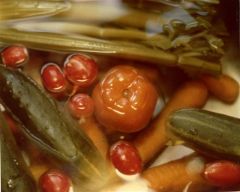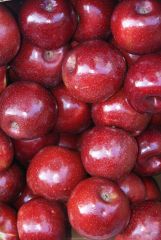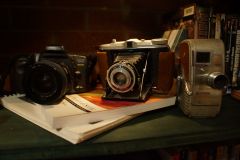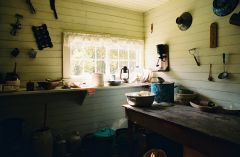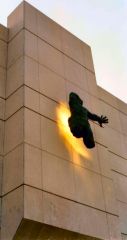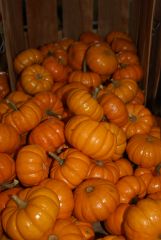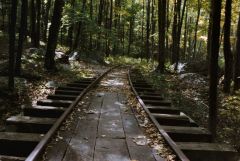-
Content Count
591 -
Joined
-
Last visited
-
Days Won
8
Content Type
Profiles
Forums
Blogs
Gallery
Everything posted by -Gramps-
-
Thanks Blackoak. I appreciate your kind comments, and yes I will keep shooting.
- 4 comments
-
- Photography
- Digital Pictures
- (and 3 more)
-

Descending to Eden
-Gramps- commented on tbutler's blog entry in Tom and Louise on Tour in North America
That is the first time I have ever heard of killer whales assisting in whale hunting...quite surprising.- 2 comments
-
- Killer Whale
- Whaling
- (and 10 more)
-
This lesson is a continuation of using your eyes and your imagination. One of the volumes in my Time Life library of photography is called The Great Themes. These photography themes include The Human Condition (life as the camera sees it) War, Nature, Portraits, The Nude, and finally Still Life. I have captured a lot of nature shots. I have taken pictures of many humans including ones in love, sad, happy and just arrived in the world. I have not dedicated much time or effort to becoming a better formal portrait photographer. It is on my list to improve that skill. The Nude or figure study as it is sometimes called, has been a subject for art for as long as the human form has existed I bet. However it creates such a mix of attitudes and taboos that I have confined my eye behind the lens to pictures of my children when they were very, very young. You know the kind of image I am talking about, the standard bathtub shot that mortifies your now adult son or daughter when the image pops up in the middle of a family slide show to a chorus of DAD!....I can't believe you are showing that! I come back with a response of Look how cute she was. I will not be posting any of those shots here, not if I want any of my kids to keep speaking to me. I think some of these themes will make for new and interesting lessons. Lets talk about shooting things when they are still. This is a very challenging form of photography. I find the thought process that goes into picturing things to be at times difficult but at times satisfying when the final product looks, well, good, to me anyway. A still life takes time to design before the shot is taken. There is the object or objects to consider, the lighting, the angle, and the story that you want to convey. You might create the design or be someplace and find it already there in front of you. There are no hard and fast rules when creating a still life, except for the obvious one, the subject must be still! The image can be of objects you arranged, such as the common bowl of fruit. The image can be a form, a shadow, a light. The pictures don't always have to be good, all of mine certainly are not, but that is not the most important thing. The important thing is to try. Shooting still life pictures is a great exercise that uses a lot of what I have tried to pass on to you. I do have a suggestion. A tripod is a very helpful piece of equipment to own when making a still life image. Long exposures are common when shooting still life images, especially when using available light. I used a tripod when taking one of the following pictures, can you guess which one that is? Let us look at a few images. The below picture of the Chrysler Museum (a wing no longer there) won third place in the open category of the first photo contest I entered many years ago. The contest was sponsored by the Portsmouth Parks and Recreation Dept in partnership with local camera retailers. This picture won third place in the still life category. I was told by one of the judges it would have won first place and been up for best in show if not for one thing the panel of judges did not like. That one thing is not in this picture because I edited it. I will show you the original image at some point. I shot the next picture at a large flea market. I walked around for hours fighting with a malfunctioning camera but managed to take one picture that I rather liked. This dining room was just as I found it. The light was from one window, as is the next picture shot in the kitchen just off the dining room. It was a very small area. The picture was shot with a 24mm lens mounted on my 35mm film camera. My question for you is: What focal length would I use if I shot this picture with my APS-C camera and kept the same angle of view? I gave a lot of thought to the next picture...I shot it on a light table with my camera positioned directly above the image, It never came out exactly the way I visioned it. I think it would have been better if the background was not textured. What do you think? Oh, the answer for the question I asked above is 16mm. Just a simple image that conveys a message about time. I shot it using available light and hand held it as well. The next shot is very simple, just apples, but for some reason people like it. I should mention that that I shot it in the horizontal format. The blog uploading program likes it the other way. I find that interesting. I said that there were no hard and fast rules for creating a still life image...so one can be whimsical don't you agree? Last is the original image of my Third Place still life. It is really neat what one can do with a good photo editing software program. Check the comments at the bottom of this blog. By the way, I used a tripod when shooting the "bowl of fruit." Now I would like to make a personal observation. I have only received one response from viewers who are members of this site. That is a bit disappointing. I was hoping for a lot more than that! I was hoping for a number of reasons. One, a blog is a bit of work (Tom and Mike would agree I am sure!) and one likes to have one's work appreciated; that is just a vanity thing. Second, I would really like to know if I am encouraging people to take better pictures, just as I am my daughter (Christine does read this blog). Third, I was hoping to have a kind of simple photo contest. Maybe that is wishing for too much. Still, I have had fun creating these blog entries and there might be some more. Thanks! Gramps.
- 4 comments
-
- Photography
- Digital Pictures
- (and 3 more)
-
This picture was "fixed" using Corel Paint Shop Pro X6. Look at the bottom edge of the picture. Do you see what I changed?
- 4 comments
-
- Photography
- Digital Pictures
- (and 3 more)
-

Britz Comes Through
-Gramps- commented on tbutler's blog entry in Tom and Louise on Tour in North America
Always nice to hear that rv problems can be solved on the road and sometimes things turn out better than they started. -
We made a dash cover out of neoprene comfort rugs...same stuff mouse pads are made from.
-
It isn't that hard to become a good photographer and good pictures that you have created have the added benefit of producing healthy endorphins.
-
yikes on the repair, and yikes on the descent, glad you made out okay on both.
-
Now if you have not been checking out the blogs here, you have missed out on some good stuff. We have a member coaching around Australia and then there is me, providing digital photography hints and tips. Here is the first post. I am sure you can find the rest from there! http://community.fmca.com/blog/62/entry-1378-a-bit-about-digital-photography/
-
I think photography is in my DNA. One of the things that fostered my interest in becoming a shooter is the fact that my Dad was one for many years. He shot thousands of pictures of places he traveled to while serving in the U.S. Navy, both at sea and shore duty. His pictures also included travels at home, to the mountains of North Carolina and Virginia as well a trip to Canada in 1967. Dad’s camera was always recording images of birthday parties, holidays, and trips to the beach. Now my daughter is learning as much as she can about digital photography. My brother shoots, as does Charity his daughter. Charity happens to be a really good photographer of children, in my opinion. I think that when you go to a studio and have a portrait of yourself or your family taken, you have a record of what you looked like at that time. When you capture a picture yourself, you create a record of what your life was like at the time you took it. You also create a record about what you are like as a person. A photograph says as much or more about the photographer as a painting says about the artist who puts brush to canvas. Just as a painter leaves his work behind, so does the photographer. Just something to think about. Lesson Five, Compose the Picture! This lesson will expand using depth of depth and the rule of thirds. We will also learn how to use framing and take advantage of diagonal and converging lines. First though, let us shake things up a bit and talk about breaking the rules. I will, on occasion, break the rule of thirds by the way I use lines. I talked earlier about how the rule of thirds adds interest to a picture by using points of interest that can have natural lines. Lines can also be man made. Multiple lines that converge together or come close to one another can be a great way to lead the eye of the viewer into a shot. These lines can cross the dead center of the frame, which technically breaks the rule. Look at the following picture. What line or lines of the picture does your eye automatically go too? Does the location of that element break the Rule of Thirds? The placement of the lines of the railroad track breaks the rule but takes advantage of it at the same time. What makes that possible? Is the rule of thirds still used in this picture as well as being broken? The position of the butterfly blatantly breaks the rule, however I used a shallow Depth of Field to create a final effect which I think makes the picture better than if I had kept the rule. Whether you adhere to the rule or not is determined by the total picture and how you frame it. Framing is composed of two parts. First is the extreme edge of the picture itself ...where it ends. Second is also what is in the picture along any edge. You see a picture before you take it and you think it will make a good image to capture, but have you really looked at it from the best vantage point? Can something be added to "frame it" and make it more than just a good shot. I believe you will see what I mean with the following two pictures. The first one is a good picture. It incorporates the rule of thirds. Notice the position of the four lines in the picture, the rock in the foreground, the fence line, the path in the distance, and the mountain ridge. Notice, too, the little bit of tree on the left side of the picture. In this next shot I kept the same four lines but I moved my position, which added an object to frame the original image, and the whole picture changes. I told you that back in my film days, making a really good picture took two exposures. One in the camera and one in the darkroom. Well I still have the opportunity to make that "second shot." I can do that using my computer and a good photo editing program. I will show you what I mean. This picture was originally supposed to be a shot of the geese. I was just learning to use the camera at a William and Mary cross country event, and while I was playing with the focus I saw the Georgetown girls track team come over the hill. This is the final product. This is the original shot before I edited it. The original image placed the girls almost dead center of the frame. The edited picture made better use of the rule of thirds, which creates a more dynamic picture even with the track team out of focus. This also exhibits once again how a shallow depth of field contributes to the picture. Knowing how to use lines, the rule of thirds, depth of field both wide and shallow and looking at the framing of your shot is going to help you create a good, and sometimes great, shot. You never know when you might need to use knowledge of all the above to create one special picture. Did I use convergent lines? Did I use the rule of thirds to position my subject? How does the depth of field of my wide angle zoom contribute to this shot? Not bad! Right? Next time we will learn how to use the brains behind the camera to help us capture that still moment in time. http://community.fmca.com/blog/62/entry-1400-when-things-are-still/ Gramps


